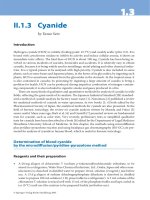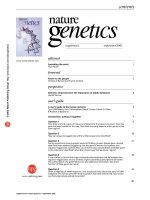HPLC A Praactical User''''S Guide Part 12 docx
Bạn đang xem bản rút gọn của tài liệu. Xem và tải ngay bản đầy đủ của tài liệu tại đây (253.44 KB, 19 trang )
Retention Time—The time or mobile phase volume need to elute and detect
a component of the mixture in a detector.
Reverse-Phase Chromatography—Separation mode on bonded phase
columns in which the solvent/column polarities are the opposite of normal-
phase separations. Polar compounds elute before nonpolar compounds,
Nonpolar columns require polar solvents.
RP
18
—Reverse phase, bonded packing with 18-carbon side chain. (See C
18
,
ODS.)
Rotor Seal—Teflon
R
surface that seals the injector and separates the flowing
mobile phase from the sample loop until an injection is completed.
Sample Clarification—Removal of particulates from the injection sample by
either filtration or centrifugation.
Saturation Column—Sacrificial column placed before the injector to protect
the main column from pH degradation.
Seal—Wear surface that both lubricates and separates moving parts in the
HPLC. (See Plunger Seal, Rotor Seal, and Needle Port Seal.)
SEC (Size Exclusion Chromatography)—A separation mode employing
control pore size packing to achieve resolution of molecules based on size
and shape. (See GPC.)
Separation Factor (a)—A measure of peak separation between peaks.Product
of dividing one peak k′ by the other. Also called the chemistry factor
because it is controlled by changes in the chemistry of the column, mobile
phase, and the sample.
SFE—Separation and filtration cartridge column. Also referred to as a SPE
(solid phase extraction column). (See windowing in Chapter 12.)
Silica—Particles or spheres of crystalline silicic acid used in chromatography.
Its surface is polar, acidic, and tends to attract water of hydration and polar
compounds.
Silylation—The first step in forming bonded-phase packings from dried silica
and chlorodialkylchlorosilanes.
Stationary Phase—A term used to describe the column packing, indicating
that it is part of a two-phase equilibrium with the mobile phase or column
solvent.
Syringe Pump—A pulseless pump made up of a motor-driven piston or
plunger in a solvent-filled cylinder. Useful only when small solvent volumes
are to be pumped; often used in micro-flow or nano-flow HPLC systems.
Tailing—Unsymmetrical peak formation in which the side of the peak away
from the injection returns very slowly to the baseline. Usually due to an
unresolved equilibration and incomplete separation.
Ultra-fast HPLC—An HPLC system designed to use <2-mm spherical packing
at high flow rate and pressure (∼12,000psi) to produce very rapid, high-
218 GLOSSARY OF HPLC TERMS
resolution separates.This system is designed for interfacing into an LC/MS
system or to increase separation speed.
Voids—Spaces or openings in the column bed leading to poor chromatogra-
phy. End voids are directly under the inlet frit. Center voids are channels
through the center of the packing bed.
Void Volume—The solvent volume inside the packed column. It usually can
be measured as an early refractive index baseline upset when injecting a
sample dissolved in a solvent even slightly different from mobile phase.
Windowing—A technique using cartridge columns (SFE) to speed chro-
matography by first removing polar and nonpolar impurities, leaving only
a solvent fraction containing the compounds of interest.
Zero Dead Volume—Fittings designed to leave no extra column volumes that
might cause band spreading or remixing of peaks.
GLOSSARY OF HPLC TERMS 219
APPENDIX E
221
This section is designed to assist in troubleshooting system problems. It is not
a systematic approach as described in Chapter 10, which always yields better
results. Keeping this in mind, I have listed a series of commonly seen prob-
lems, possible causes, and suggested treatments.
Problem 1: No power. (Display does not light up on module or system.)
Cause a: Not plugged in.
Treatment: Check the plug at the socket and at the module. It may have
worked loose or been unplugged accidentally.
Cause b: No fuse, blown fuse, or incorrect fuse.
Treatment: On a new system, make sure fuse(s) were installed. If vari-
able voltage, make sure the selection card is correctly positioned.New
systems are often shipped with fuses in a bag.If fuse is broken, replace
it and contact service.
Cause c: Not switched on.
Treatment: Turn on the switch (from the front, try the upper right-hand
side of the back plate). Someone may have been helping you to con-
serve energy. I always set my system up on a common surge protec-
tor with an on/off switch. That way I can turn everything on with one
switch and protect against line surges and ground loops at the same
time.
Problem 2: Leaking frits, puddles on desk top, fountains of solvent.
Cause a: Compression fittings not tight enough.
Treatment: Tighten leaking fitting another 1/4 turn or until leak stops.
(Leaks will be at the back of the fitting around the tubing.)
HPLC TROUBLESHOOTING
QUICK REFERENCE
HPLC: A Practical User’s Guide, Second Edition, by Marvin C. McMaster
Copyright © 2007 by John Wiley & Sons, Inc.
Cause b: Incorrectly made fitting or wrong ferrule.
Treatment: Stop pump.Loosen fitting with a wrench. Examine for correct
preparation. Cut off and replace if necessary. (Leak is usually around
the base of the connected fitting.)
Cause c: Fitting scored by silica packing left in threads.
Treatment 1: Wrap fitting with Teflon
R
tape and reseat.
Treatment 2: Cut off ferrule and replace fitting.
Problem 3: Inconsistent or too slow pump flow rate.
Cause a: Air bubble in pump head.
Treatment 1: Open a purge valve. Prime the pump with degassed solvent.
Treatment 2: Open the compression fitting at the top of the outlet check
valve with a slow pump flow until solvent leaks around the fitting.Tap
the side of the check valve with a small wrench until small air bubbles
come out with the liquid. Reseat the compression fitting.
Treatment 3: Pacify the pump with 20% nitric acid after first removing
the column and replacing it with a column bridge. Wash repeatedly
with water.
Cause b: Plugged solvent sinker in reservoir.
Treatment: Replace filter (sinker is plugged, pump is starving). Try soni-
cating stainless steel frits in 20% HNO
3
, then sonicate in fresh water.
Cause c: Outlet check valve is sticking open.
Treatment: Pacify pump with 20% HNO
3
(see 3b).
Cause d: Sticky inlet check valve. Solvent flows back into reservoir.
Treatment 1: Replace check valve.
Treatment 2: Pacify system (see 3b).
Problem 4: Pump pressure shuts down pumping.
Cause a: Pump overpressure setting set too low.
Treatment: Reset overpressure setting to a higher value, if the column
can tolerate it.
Cause b: Under-pressure setting too low. No solvent.
Treatment: Reset under-pressure setting higher. Check solvent reservoir
and add more solvent if necessary.
Cause c: Column or system plugged.
Treatment 1: If pressure exceeds 4000psi, find the plug and clear it.
Remove the column and run pump(s). If pressure persists, trace pres-
sure source back toward the pumps until the pressure drops. Reverse
the line and use pump pressure to blow plug out.
Treatment 2: If pressure leaves with the column,replace the inlet frit (See
Chapters 6 and 10).
Problem 5: No peaks detected after injection.
Cause a: No sample pulled up into injection syringe.
Treatment: After drawing up sample, pull back on syringe barrel so you
can see the meniscus. Tap out bubbles. Push syringe back to injection
size mark. Wipe off excess liquid with tissue. Inject.
Cause b: Injector loop plugged.
222 HPLC TROUBLESHOOTING QUICK REFERENCE
Treatment: Make sure solvent flows from injector waste line when
loading loop. If not, disconnect injection loop at point closest to
column and place injector in inject position with pump flow on. Wash
loop into beaker and reconnect.
Cause c: Wrong elution solvent used. Gradient run not started.
Treatment: Use correct elution conditions. Make sure you start gradient
run.
Cause d: Column has bound impurities.
Treatment:Wash column into a beaker with strong solvent.Reequilibrate
with mobile phase. Inject new sample.
Cause e: Detector setting too high. Wrong wavelength selected.
Treatment: Check detector settings. Increase sensitivity. Inject again.
Cause f: Sample cannot be seen by detector.
Treatment 1: Select a wavelength at which the sample can be seen. Scan
standards in spectrophotometer to find a useable wavelength.
Treatment 2: Select a universal detector that can see sample, if one is
available. RI, MS, CAD, and ELSD detectors can see most samples.
Problem 6: Injector leaks around body or around needle when in port.
Cause a: Injector body leaks because of torn injector seal.
Treatment: Rebuild injector by replacing injector seal.
Cause b: Needle seal has been scored by sharpened injection needle.
Treatment: Tighten sleeve around needle seal or replace the seal.
Problem 7: Ghosting peaks occur when injecting only solvent.
Cause a: Dirty sample loop.
Treatment: Clean sample loop by washing with strong solvent.
Cause b: Small rotor seal tear is trapping sample.
Treatment: Replace the rotor seal.
Problem 8: Increasing column pressure.
Cause a: Column inlet frit is plugging.
Treatment 1: Filter samples before injecting them.
Treatment 2: Wash column with water before switching from buffer
to a stronger organic solvent. Wash with water before return to
buffer.
Treatment 3: Remove frit and replace it. Wash old frit by sonicating with
20% nitric acid and then water (see 3b).
Cause b: Column bed is plugged.
Treatment:Avoid injecting a saturated sample solution. Column will over
concentrate and precipitate sample. Wash out at best flow rate with a
strong solvent without triggering over-pressure setting.
Cause c: Outlet frit has become plugged with packing material fines.
Treatment:Replace outlet column frit. Sonicate old frit with 10% NaOH,
water, and again with water (see 3b).
Problem 9: Column retention time and plate count changing.
Cause: Bound material on column or column voiding.
Treatments: See Chapter 6.
HPLC TROUBLESHOOTING QUICK REFERENCE 223
Problem 10: Loss of detector sensitivity and dynamic range.
Cause a: Old detector lamp is failing.
Treatment: Replace detector lamp. Record new intensity value, if it can
be measured, for later reference.
Cause b: Dirty flow cell window.
Treatment: Clean windows. First, try cleaning in situ. Disconnect detec-
tor from system, wash with strong organic solvent from syringe and
tube connected to flow cell inlet. If this does not solve problem, wash
with water. Check manual to see if flow cell can be pacified with nitric
acid. Push 20% nitric acid in from the waste line and trap in flow cell.
Leave for 15min. Flush out copiously with water. If necessary, disas-
semble flow cell and clean window with acetonitrile, chloroform, and
then hexane, wiping with tissue. Dry and reassemble.
Problem 11: Baseline increases with no solvent flow and detector lamp on.
Cause: Decomposing coating on flow cell windows.
Treatment: Wash windows or pacify with 20% nitric acids (see 10b).
Problem 12: Rising and falling chromatographic baseline.
Cause a: Late running peaks are still eluting off column.
Treatment: Wash column with stronger solvent. Equilibrate with fresh
mobile phase.
Cause b: Detector warm up is not complete.
Treatment: Go have another cup of coffee before shooting another
sample. If warm-up time becomes excessive, consider replacing the
lamp or calling a serviceperson.
Problem 13: Noisy baseline or baseline spikes.
Cause a: Bubbles in flow cell.
Treatment 1: Add 40–70psi back-pressure device to detector outlet line.
Treatment 2: Disconnect detector. If acid-resistant, pacify by pushing
20% nitric acid into flow cell and trapping it, followed by water wash
out (see 10b).
Cause b: Electronic noise coming from the power line.
Treatment 1: Get a line noise filter.
Treatment 2: Make sure the detector signal line is properly shielded.Only
one end of the line should be connected to ground.
Problem 14: Chromatographic peaks have plateaus or unexpected shoulders.
Cause: Strip chart or printer slide wire or bar is dirty and sticking.
Treatment: Pen or printer head is sticking. Wipe slide wire or bar with a
lint-free tissue. Spray WD40 on tissue and wipe slide wire or slide bar
if problem reoccurs.
Problem 15: Retention times vary in both directions on rerunning sample.
Cause: Stretched tension spring on strip chart drive.
Treatment 1: Check strip chart bed speed with a stopwatch. Reposition
spring attachment to increase tension.
Treatment 2: Get an integrator or a computer-based data system. Put the
strip chart back on the GC or trash it.
224 HPLC TROUBLESHOOTING QUICK REFERENCE
Problem 16: Continuous retention time printing is occurring.
Cause: Noise level is set too low. Each baseline deflection is seen as a peak.
Treatment: Increase noise setting level until only retention times of peaks
of interest are printed with retention times.
Problem 17: Integration start/stop marks occur too early or late.
Cause: Peak width is too small. Slope reject is too high.
Treatment: Use auto zero or test button before making injection. Recal-
culate using higher noise value, lower slope value, or a wider initial
peak width until chromatogram is correctly displayed. (see Chapters
9 and 14)
HPLC TROUBLESHOOTING QUICK REFERENCE 225
APPENDIX F
227
The following laboratory experiments have been designed to let you try out
the tools you need to run an HPLC system and its columns on a daily basis.
In Laboratory 1, you will practice starting up an HPLC, recovering a dry
column, and quality controlling a new column. In Laboratory 2, you will run
a scouting gradient to select an isocratic condition. An SFE cartridge column
will be used to window out peaks in the chromatogram. In Laboratory 3, we
will look at the effect of changing the stronger solvent and changing column
types on our standards separation. Finally, we will remove the column and
pacify the system with 20% nitric acid followed by a water washout. Using
these tools on a regular basis should keep your columns and systems up and
running and provide procedures when you have to develop new separations.
LABORATORY 1—SYSTEM START-UP AND COLUMN
QUALITY CONTROL
Purpose
1. To start up an HPLC protecting seals, plungers, and a “dry” column.
2. To run column standards.
3. To calculate plate counts/retention times.
Equipment and Reagents
1. Isocratic HPLC system
2. C
18
column (5mm, 15–25cm)
HPLC LABORATORY
EXPERIMENTS
HPLC: A Practical User’s Guide, Second Edition, by Marvin C. McMaster
Copyright © 2007 by John Wiley & Sons, Inc.
3. 25-mL injection syringe
4. HPLC-grade methanol and water
5. Column Standards (P.J. Colbert Ct. No. 962202)
6. Column blank (5ft of 0.010-in tubing, fittings, and unions)
7. 70psi back-pressure device on the detector outlet
Protocol
1. Prepare 200mL of 50% methanol/water and 100mL of 80%
methanol/water. Vacuum filter through 0.54-mm filters.
2. Remove the C
18
column, cap, and set it aside. Set up the HPLC system
with a column bridge in place of the column. Prime the pump(s) with
50% methanol/water. Set the over pressure setting on the pump to 4000
psi. Stat flow at 0.1mL/min and slowly ramp to 1mL/min. Watch the
pump pressure indicator for fluctuations (air bubbles? dirty check
valves?). (Lab Note: Air bubbles can be cleared by opening the com-
pression fitting on the outlet check valve with a wrench until solvent
bubbles out, then tapping the valve housing lightly to release bubbles.
Retighten the compression fitting and move to the next check valve
fitting until you have checked them all or the problem has disappeared.)
Stair-stepping pressure problems may indicate a dirty check valve,
which should be replaced or pacified (see Laboratory 3).
3. When the pressure is steady, turn the injector handle to inject (or load
if it was already in the inject position) and watch the pressure. If the
pressure does not jump up, the loop is not blocked. Cycle the injector
handle to the inject position.
4. Watch the recorder or computer baseline. When it is stable, slow the
pump flow to 0.1mL/min,remove the column blank,and connect the C1
8
column to the injector. Do not connect the column to the detector yet.
Wash the column solvent into a beaker (start a slow flow ramp up from
0.1 to 1.0mL/min) for six column volumes (12–18mL). Pressure should
slowly increase to around 2000psi at 1mL/min due to column back-
pressure. (Lab note: Always hook up a column with solvent running to
prevent introducing air from the column head into the column.)
5. When the pressure is stable, record column back-pressure from the
pump pressure gauge in a logbook. Connect the column to the detec-
tor inlet fitting.Turn on the detector (select 245nm, 1.0 AUFS) and the
recorder at 0.5cm/min chart speed. Observe the baseline. Drifting indi-
cates that the detector is still warming up or something is washing off
the column. (Lab note: The pump pressure gauge should be monitored
periodically when making changes to a system. A sudden pressure
increase indicates a blockage problem. Adjusting the pump over-
pressure setting should prevent problems, but shut off the flow yourself
and figure out what is causing the extra pressure to be sure.)
228 HPLC LABORATORY EXPERIMENTS
6. When the baseline is stable,inject 15mL of column standards.(Lab note:
Inject by overfilling the syringe, point the needle up, pull the barrel back
until you can see the meniscus, tap out visible bubbles in the liquid,
push the plunger to the 15-mL mark, wipe outside the barrel with a lab
wipe with a pulling motion. Insert into injector. Load the injector loop
slowly, and leave the needle in place.) Turn the injection handle quickly.
Remove the injection needle, and flush three times with solvent.
7. On the chromatogram paper, mark the inject point. Record date, time,
operator name(s), flow rate, mobile phase, sample type, number, injection
amount, column,detector wavelength, attenuation,and the chart speed so
you could duplicate this run. Record chromatogram until the baseline
is reached after the four peaks.
8. Repeat standards run. Increase recorder speed to 2cm/min. Inject stan-
dards solution. Record the four-peak chromatogram.
Results
9. Using the chromatogram recorded at 2cm/min, measure V
0
, the exclu-
sion volume of the column, V
x
for each peak (the solvent volume at the
peak center), and W (the 5s width) for peaks 1 and 4.
10. Calculate k′ (peaks 1 and 4), a (peaks1,2), and N (1 and 4).(Lab note:
Remember k′(1) = V
1
− V
0
/V
0
, a(1,2) = k′
2
/k′
1
, N
1
= 16(V
1
/W
1
)
2
. Also
remember that W
1
is measured by projecting lines parallel to the sides
of the peak to where they intersect the baseline. W
1
is the distance
between the intersection points.) (see Ch. 4)
LABORATORY 2—SAMPLE PREPARATION AND
METHODS DEVELOPMENT
Purpose
1. Run a scouting gradient.
2. Select SFE cartridge column windowing conditions from the gradient.
3. Run SFE window cuts in selected dial-a-mix conditions.
Equipment and Reagents
1. Gradient HPLC system
2. C
18
HPLC column (5mm, 15–25cm)
3. C
18
SFE cartridge columns (Whatman Part No. 6804-0405)
4. 5-mL B-D disposable syringes
5. Seven-components test mixture (P.J. Colbert Cat. No. 962201)
6. HPLC-grade methanol and water
7. 10-mL test tubes
SAMPLE PREPARATION AND METHODS DEVELOPMENT 229
Protocol
1. Purge pump A with water and pump B with methanol. Dial-a-mix 20%
B and equilibrate the column at 1.5mL/min (six column volumes or a
stable baseline at 254nm, about 10min). (Lab note: If the gradient system
is a low-pressure mixing system, solvents must be degassed by purging
or running under helium.)
2. Inject 15mL of the seven-component standard. Run a 15-min gradient to
100% methanol, hold at 100% for 5min. Watch the chromatogram
during the run and record %B of the first and last peaks.
3. For a 25-cm column, deduct 10% from the first peak’s %B and equili-
brate the column with this dial-a-mix mobile phase (i.e., if the first peak
came off at 80% B, dial-a-mix 70% B). For a 15-cm column, deduct 7%
from the first peak %B to find your dial-a-mix isocratic. Equilibrate the
column with this mobile phase.
4. Inject standards and run the chromatogram.
5. Pretreat a C
18
cartridge column with 2mL MeOH, then 2mL, of water.
(Lab note: Remove plunger from a 10-mL syringe. Put the cartridge
column on the luer end of the syringe tip. Put 2mL of MeOH in the
syringe barrel. Put solvent and air through the cartridge with the plunger
and collect eluant in waste test tube. Do not pull back on the syringe
barrel while cartridge is attached. Remove cartridge. Pull out plunger.
Replace cartridge on tip. Go to next wash solvent.
6. Dilute 1mL of standard solution 3-fold with water. Put sample in syringe
barrel with cartridge in place. Insert the barrel and push the sample into
the cartridge. Collect the effluent as collect tube 1. Based on the scout-
ing gradient, select three washes to window off standards. Select a
window that should leave the three middle compounds in the second cut
(Lab note: In windowing from a scouting gradient, start at the injection
mark and move to the last peak you want to wash off in the first cut.
Find its equivalent %B on the gradient trace. Deduct 7–10% B to find
its isocratic equivalent for your first wash condition. Wash the cartridge
with 1mL of this eluant. Collect it as collect tube 2. On the chro-
matogram, move to the last peak you want in your second window frac-
tion and determine its equivalent wash off %B.Wash the cartridge with
1mL of this %B. Collect it as collect tube 3. Finally, wash the remaining
peaks off the cartridge with 1mL of 100% methanol. Collect this as
collect tube 4.
7. Run 15mL of each collect tube in the isocratic dial-a-mix mobile phase
chosen in step 4.
Results
8. Examine the four chromatograms of the breakthrough and windowing
cuts (collect tubes 1–4). Measure retention times of the peaks in each
230 HPLC LABORATORY EXPERIMENTS
collect tube and compare with the final methods development chro-
matogram. If you found more or less than three peaks in collect 3, or if
some of the cut 3 peaks are found in cuts 2 or 4, indicate how you would
adjust the %Bs of the window frame to improve cut 3. Do not repeat
the windowing experiment to prove your point! (See Section 12.1.3–5 if
you have questions on windowing.)
LABORATORY 3—COLUMN AND SOLVENT SWITCHING
AND PACIFICATION
Purpose
1. Study the effect of changing the stronger solvent or the column.
2. Do a column washout and QC check.
3. Do a system pacification using a column blank.
Equipment and Reagents
1. Gradient HPLC system
2. Back-pressure device on the detector outlet
3. C
18
column (5mm, 15–25cm)
4. C
8
column (5mm, 15–25cm)
5. Column blank (5ft of 0.01-in tubing, fittings, and unions)
6. Four-component column standards (P.J. Colbert Cat. No. 962202)
7. Seven-components test mixture (P.J. Colbert Cat. No. 962201)
8. HPLC-grade acetonitrile, methanol, and water
9. Concentrated nitric acid
Protocol
1. Purge line A with water and line B with MeOH.Dial-a-mix 70% MeOH
and equilibrate the C
18
column at 1.0mL/min. When stable, inject 15mL
of the seven-component test mixture and annotate the chromatogram’s
start. Run an isocratic chromatogram.
2. Reduce the flow to 0.1mL/min, remove the C
18
column, and replace it
with the C
8
column (do not connect to the detector). Increase the flow
to 1.2mL/min and wash with six column volumes of mobile phase.
Connect the column to the detector inlet and run until the baseline is
flat.
3. Inject 15mL of the seven-component standards test mixture. Annotate
and run an isocratic chromatogram.
4. Dial-a-mix 60% methanol/water. Equilibrate the C
8
column. Inject
15mL of the seven-component standards mixture. Annotate and run an
isocratic chromatogram.
COLUMN AND SOLVENT SWITCHING AND PACIFICATION 231
5. Put acetonitrile in the B reservoir. Purge the pump inlet line with ace-
tonitrile. Dial-a-mix 60% acetonitrile/water. Reconnect the C
18
column
at 0.1mL/min. Increase the flow to 1.0mL/min and equilibrate the
column. Inject 15 mL of the seven-component test mixture. Annotate
and run the chromatogram.
6. Make up 100mL of 20% nitric acid (1 part acid added to 4 parts water).
7. Very Important Lab Note: Remove the column! Replace the column
with the column blank. Put end fittings on the column for storage. Put
water in the reservoir and wash the system at 2mL/min with water.
8. Check your HPLC system manual to make sure the system is compati-
ble with nitric acid washing. Make sure the reservoir sinker is made of
stainless steel and not monel metal. Replace the water in the solvent
reservoir with 20% nitric acid. Stop! Note: Make sure the column has
been replaced with the column bridge. Do not pump nitric acid through
a bonded-phase column. Wash the system for 15min at 2mL/min with
6 N (20%) nitric acid. Discard the wash carefully.
9. Wash the system with water (2mL/min) (set UV detector at 230nm, 2.0
AUFS) and monitor baseline for disappearance of nitric acid. When
baseline is flat or your class time has elapsed, collect effluent and check
pH against laboratory water.
Results
10. Examine chromatograms of standards run on the C
8
and C
18
columns
for peak shifting. Examine chromatograms run in methanol/water and
acetonitrile/water for peak shifting. Measure last peak retention times in
all three chromatograms. Look for peak switching by looking at peak
heights and positions.
11. Pacification of a columnless HPLC with nitric acid: Observe the length
of time necessary to wash all the nitric acid out of the HPLC system.
232 HPLC LABORATORY EXPERIMENTS
APPENDIX G
233
Journals
1. LC-GC Magazine
—“Sample Preparation Perspectives,” Ron Majors
—“LC Troubleshooting,” John Dolan
—“The Data File,” Glen Ouchi
2. American Laboratory
—“The World of Separation Science,” Robert Stevenson, ed.
3. Journal of Liquid Chromatography
4. Analytical Chemistry
5. Journal of American Society of Mass Spectrometry
Web Sites
1. LC/GC (Europe), www.lcgceurope.com
2. LC/GC (North America), www.lcgcmag.com
3. LC/GC (TechExpo—Ron Majors), www.techexpo.com
4. Guide to HPLC, www.pharm.edu
5. Chiral HPLC Guide, www.raell.demon.co.uk
6. HPLC portal, www.hplcweb
7. HPLC troubleshooter, www.dq.fct.unl.pt
SELECTED REFERENCE
LIST
HPLC: A Practical User’s Guide, Second Edition, by Marvin C. McMaster
Copyright © 2007 by John Wiley & Sons, Inc.
Papers
1. Hopfgartner,G.,Wachs T.,Bean, K.,and Henion J.“High-Flow Ion Spray
Liquid Chromatography/Mass Spectrometry,” Anal Chem., 65, 439–446,
1993.
2. Henry, R.A. “Highly Selective Zirconia-Based Phases for HPLC,” Am.
Lab., Nov. 2002, 18–25.
3. “High Temperature:The Future of HPLC”ZirChrom Newsletter,Vol. #5,
2002.
4. Tiller, P.R., et al., “Qualitative Assessment of Leachables Using Data-
Dependent Liquid Chromatography/Mass Spectrometry and Liquid
Chromatography/Tandem Mass Spectrometry” Rapid Commun. Mass
Spectrom., 11, 1570–1574, 1997.
5. Loyd, J.D. “Advance in HPLC: Monolith Silica Columns,” Literature
Seminar, U.Alabama, 4/1/2003, 11 pp.
6. Murphy, B. and Swartz, M. “UPLC: New Frontiers in Chromatography,”
Am. Lab., Feb. 2005, 22–27.
Books
1. Introduction to Modern Liquid Chromatography, 2nd L.R. Snyder and
J.J. Kirkland (eds), John Wiley & Sons, New York, 1979, 863 pp.
2. Reversed-Phase High Performance Liquid Chromatography, A.M.
Kristulovic and P.R. Brown, John Wiley & Sons, New York, 1982,
296 pp.
3. Practical HPLC Methods Development, 2nd Ed. L.R. Snyder, John
Wiley & Sons, Inc. New York, 1997, 750 pp.
4. HPLC Columns: Theory, Technology, and Practice, U.D. Neue, Wiley-
VCH, New York, 1997, 390 pp.
5. Liquid Chromatography in Clinical Analysis, P.M. Kabra and L.J.
Marton (eds), The Humana Press, Clifton, NJ, 1982, 466 pp.
6. Basic Liquid Chromatography, E.L. Johnson and R. Stevenson, Varian
Associates, Inc., Palo Alto, CA, 1978, 354 pp.
7. Protein Purification, J.C. Jansen and L. Ryden (eds), VCH Publishers,
New York, 1989, 502 pp.
8. LC/MS Applications in Drug Development, M. Lee,Wiley-Interscience,
New York, 2002, 243 pp.
9. LC/MS: A Practical User’s Guide, M.C. McMaster, Wiley-Interscience,
New York, NY, 2005, 165 pp.
10. GC/MS: A Practical User’s Guide, M. McMaster and C. McMaster,
Wiley-VCH, New York, 1998, 167 pp.
234 SELECTED REFERENCE LIST
INDEX
5 sigma (s) width, 49
Acidic phase silica, 93
Alpha (a) 55
A/D converter, 124
Affinity column, 59, 101
Amine column oxidation, 75–76
Amino acids, 162
AMU (atomic mass unit), 183
Analytical mode, 8
Analog to digital, 167–168
Anionic ion exchange, 97
Antibody purification, 112
Application trends, 165
Atmospheric pressure interface, 181
Automated gradient development, 176
Automated methods, 172
Autosampler, 114, 175, 206
Back pressure regulator, 30
Baseline setting, 170
Best column selection, 208
Bound material, 78
Buffer,
use, 90, 206, 209
volatile, 90, 211
wash out, 79
C
18
column, 53
Calibration standards, 172
Capillary columns, 188, 191
Carbohydrates, 160, 207
Cationic exchange column, 86
Cappilary zone electrophoresis (CZE),
13
Cavitation, 112
Center-voids, 83
Channeling, 82
Charged aerosol detector (CAD), 11,
207
Chelators, 92
Chip HPLC, 192
Chromatogram, 8
Clinical drugs, 163
annotation, 39
Column,
blank, 29, 107
change time, 209, 231
cleaning, 82, 210
design, 5
equilibration, 35
healing, 73, 209
life, 209
packing, 66
selection, 66
variations, 61–62
Compound identification, 88
Computer, 124
Conductivity detector, 18
Coronal discharge needle, 188
Data acquisition,
computer, 13, 123–124, 132
Data Interpretation, 170
Daughter ion, 185
fragmentation, 188
HPLC: A Practical User’s Guide, Second Edition, by Marvin C. McMaster
Copyright © 2007 by John Wiley & Sons, Inc.
235
236 INDEX
Dc/RF scans, 123
Deconvolution software, 188
Denaturing compound, 100
Deproteination, 144
Derivatives, 151
Desalting columns, 98
Detectors, 8, 116
Development “rule of one”, 176
Digital data interchange, 169
Digital signal, 124
Digital to analog, 169
Disappearing peak. 80
Drug development, 164
Drugs of abuse, 163
Efficiency factor, 48–49
Electrochemical detector (EC), 122
Electrophoresis, 12, 197
Electrospray interface (ESI), 187
End-capping, 63
End voids, 77
Encapsulated compounds, 147
Evaporative light scattering detector
(ELSD), 118, 207
Environmental monitoring, 164
Exclusion volume, 56
Enzyme proteins, 162
Enzyme recovery, 100–101
Fast chromatography system, 207
Fast protein liquid chromatography
(FPLC), 10
Fat-soluble vitamins, 139
Filtered samples, 207
Fittings, 16, 27
Fluorescence detector (FL), 122
Fourier transform MS (FTMS), 185
Fraction collector, 123
Fragmentation patterns, 185
Frit, 5
cleaning, 82
Gas liquid chromatography (GLC), 11
Gel electrophoresis (GEP), 12
Gel permeation, 57
chromatograph (GPC), 57
Glycoprotein purification, 100–101
GPIB data/control cables, 169
Gradients,
continuous solvent, 8
development, 156
performance test, 112
step, 9
system use, 109, 206
Gradient controller, 109
high pressure mixing, 110
low pressure mixing, 111
Guard column, 70
HPLC,
problem points, 125
separation, 4
system types, 13, 19
versatility, 3
water, 207
wetted path, 125
HPLC system automation, 169
Hybrid-silica, 63–64
Inclusion volume, 59
Inert surfaces, 107, 206
Injection, reproducible, 38
Injector, 113
Integration reproducibility, 132
Integrator, 124
Internal standards, 38
Ion exchange, 56, 96
column repair, 97
Ionization, 187
suppression, 90
Ion pairing, 91, 209
Ion repeller, 188
Ion spray interface (ISI), 187
Ion trap detector (ITD), 185
Isocratic system, 105
k¢ (retention factor), 48, 52
LC (traditional liquid chromatography),
10
LC/LC/MS/MS system, 197
LC/MS system, 182
LC/MS/MS system, 185
Light scattering detector (ELSD), 118
Linear ion trap detector (LTD), 185
Lipids, 159
INDEX 237
MALDI TOF MS system, 189
Mass ion, 185
Mass selection, 183
Mass spectrometer, 118
Mass spectral detector (MSD), 207
MSD upgrading, 208
Metal cation chelation, 80
Methods development, 151
Micro flow chromatography, 199
Microfluidics, 192
Micro-parallel HPLC system, 197
Microporous packing, 62
Mobile phase scouting, 39
Molecular ion, 185
Molecular weight, 188
Molecular weight columns, 59, 98
Monolith columns, 196, 210
MS inlet, 188
MS/MS, 133
MS
n
-type experiments, 185
Multimode MS source, 189
N (efficiency factor), 18, 49
Nanospray interface, 187
Nebulizing inert gas, 188
Nebulizer capillary, 188
Nanospray interface, 187
Normal phase, 52
column cleaning, 84
Nucleic acid & nucleosides, 161
Ocyldecyl (ODS, C
18
) columns, 53
Organic acids, 160
Organic modifiers, 92
Overpressure setting, 206
Oxylate column washing, 80
Pacification, 107, 128, 207, 231
Partition, 45
modification, 89
Peak heights/areas, 37, 41
Peak tailing, 89
Peak detection, 124, 171
Pellicular packings, 62
Peptides, 162
Pesticides, 164
PH & pKa, 90
Phospholipids, 207
Plate counts, 37, 50
Polarity, 45
Porous packing, 62
Portable LC/MS, 198
Polymeric column,
protection, 87
washing, 87
Polynuclear aromatics (PNAs), 164
Preparative,
column, 69
mode, 8
scale, 138
Pressure increase, 81
Proteomics, 162, 185
Pumps, 108
Pumpheads, 109
Quadrupole MS, 183
Quantitation, 172
Radiolabel detector, 123
Reactor monitoring, 165
Refractive index detector (RI),
116–118
Resolution equation, 48–49
Response factors, 172
Resolution sum scouting, 173
Retention factor (k′), 48, 52
Reverse order diagnosis, 129
Reverse phase, 52
Roughing pump, 187
Sample cleanup, 36
Sample extraction, 145
SFE cartridge, 11, 32, 70, 145, 206,
230
windowing, 149
Sample preparation, 143, 206
Saturation column, 70
SCAN mode, 183
Scouting gradients, 110
Semi-preparative scale-up, 139
Separation factor (a), 48, 53–55
Separation,
isocratic, 9
models 5–6
modes, 22
ranges, 9
238 INDEX
Separation guide, 203
Sequential analysis, 69
Serial detectors use, 123
Shave/recycle, 140
Silica, 46
ionization, 86
Silylation, 63
Simplex optimization search, 174
SIM mode, 183
Size exclusion, 57–58
Size exclusion column, 70
cleaning, 85
Size separation, 95
Sodium dilauryl sulfate (SDS), 100
Solvent filtration, 31
Solvents,
helium sparged, 112
Spherical packing, 63
Spotter plate interface, 189
Standardized LC/MS method, 193
Standards development, 152
Standards filtration, 107
Standards test mixture, 37
Start-up, 25, 34, 227
Steroids, 159
Stokes radius, 98
Stronger solvent, 55
Structural information, 188
Supercritical fluid chromatography
(SFC), 11
Syringe pump, 191
Tandem mass spectrometer (MS/MS),
183
Temperature–controlled
chromatography, 195
Test mixture, 37
Thermospray interface, 187
Thin layer chromatography (TLC), 12
Time-of-flight (TOF) MS, 185
Toxicology, 163
Trace enrichment (SFE), 148
TSK column crushing, 85
Tubing, 26, 51
Two-dimensional HPLC, 197
2D-gel electrophoresis (2D-GEP), 197
Ultraperformance LC (UPLC), 192, 196,
207
Variable UV detector, 15, 119
Void volume, 47
Volatile buffers, 90, 187, 211
Water purity test, 33
Water-soluble viatamins, 160
Zirconium affinity kits, 102
Zirconium,
columns, 59, 72, 75, 93, 207
high temperature use, 93
ion exchange, 95
ionization, 86,-8
reversed phase, 210









